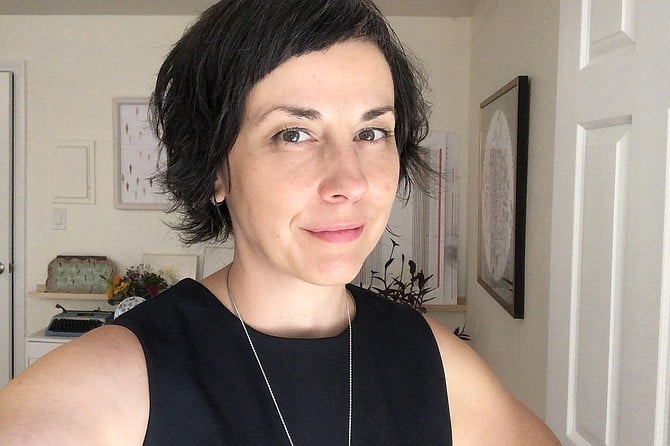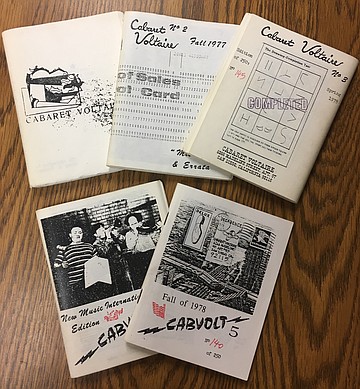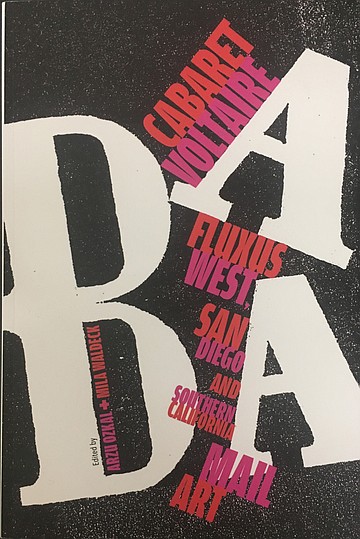 Facebook
Facebook
 X
X
 Instagram
Instagram
 TikTok
TikTok
 Youtube
Youtube

A classified ad appeared in the February 3, 1977 edition of The San Diego Reader. It read, “Creative writers, artists, freaks with ideas for avant-garde journal wanted. Contact Cabaret Voltaire c/o Steve Hitchcock 626 Madeline St. Apt. 97 San Diego 92115. Zip a dee dada.” That last word, a reference to the early 20th-century irrationalist European art movement, may have been the key to his ad’s success. It signified that the teenaged SDSU journalism student knew the significance of his chosen title, which was also the name of the movement’s birthplace in Zurich.
Only three people responded, but one of those three was Ken Friedman, the founder of Fluxus West, the California outpost of the Fluxus group, which, according to Friedman’s history of it, sought “to promote and care for a wide variety of concerns in contemporary art, which at that time represented highly experimental viewpoints in the art world.” Friedman gave Hitchcock access to something far less haphazard than a weekly paper’s classified section: a mailing list of mail-art participants from all over the world, a kind of pre-internet image-sharing network. The result was a five-issue run of a Xeroxed zine, one that, improbably, featured mail-art heavy hitters like Anna Banana and Ray Johnson in its first issue.

Twenty-one years after the appearance of Hitchcock’s classified, Turkish graphic design student Arzu Ozkal yielded to the urgings of her classmates and attended a performance by Fluxus member Benjamin Patterson, given as part of the Istanbul Biennial. As Ozkal — now a Professor of Design at SDSU — tells it, Patterson invited students onstage, gave each of them roses, cut the roses with scissors, dropped the blooms into a blender, blended them, and then drank the resulting puree. “I was intellectually disoriented when I left the concert hall,” she recalls. “Absurdity, spontaneity, noise, mess, and audience participation were not part of the ‘elements of visual education’ that I learned so well in my classes until then. It was playful and fun, everything I wasn’t doing in school. All my projects changed after that; they all had this absurd quality.”
Disorientation gave way to inspiration, to the point where she eventually co-authored a sort of manifesto to encourage “more ‘Fluxus’ within the design process. Taking responsibility together for an unpredictable outcome. It’s not about what you’re hanging on the wall, it’s what you did up until that point.” That included the kind of collaborative work prefigured in the practice of mail art. These days, that often means shared Google drives that allow for more instantaneous back-and-forth, but the principle remains the same. And even today, she notes, “there’s something significant about receiving mail. When you receive a postcard from somebody, it’s Christmas in July.”
It is perhaps easy to imagine, then, Ozkal’s delight in 2017, when she read in the source book Correspondence Art, “Little magazines have appeared in alternative spaces for mail artists. Included are short-lived Cabaret Voltaire, created by Steve Hitchcock in San Diego…” A genuine relic of the movement that had inspired her, right where she lived and worked — issue one was tucked away in the SDSU Special Collections. But only issue one. She began an impassioned search for the rest of this precious cache of print media.
Naturally, she started online. “Facebook. We hate it, but it’s an interesting tool. I was hysterically searching for Cabaret Voltaire. And there was a picture that Jan posted” — Jan Tonnesen, former manager of Wahrenbrock’s Book House, the great old downtown used bookstore that burned in 2006. “I messaged him, and he responded immediately: ‘Oh, I have all of them in my garage.’ He’s an amazing archivist. Apparently, the zines were sold at Wahrenbrock’s, and he bought them at the time.” When they met, Ozkal was the one doing the buying.

Her next search for was for CabVolt’s creator. This time, Facebook was no help. “I messaged every Steven Hitchcock on Facebook: ‘Are you this person?’” Instead, YouTube provided the first breadcrumb on the trail. “Mail art artists were really into underground music as well. I found this YouTube video of a Steven Hitchcock jamming with Faust in Death Valley. That led me to a radio station in San Francisco, and they forwarded my email” to the person who had been Steven Hitchcock, but who was now living as Ferrara Brain Pan. They connected. “I don’t think [Brain Pan] really understood the volume of [what he was making],” says Ozkal. “He just did it because he was interested in underground publishing and interested in connecting to people.” Nevertheless, Ozkal told Brain Pan about her desire to put together a project celebrating his project, one eventually that resulted in the book Cabaret Voltaire: Fluxus West, San Diego, and Southern California Mail Art.
The book contains numerous grainy images from the original run of Cabaret Voltaire, a series of essays on its contents and significance, and substantial commentary from Ken Friedman, the man who kickstarted the project back in 1977. And it concludes with an invitation to submit works for “a new CabVolt zine out of the space and time fabric that is San Diego, California.” That might seem like an unusually sentimental notion, given that the blog platform replaced the Xerox machine over twenty years ago. But Ozkal isn’t so sure. “When Google came out,” she notes, “it was like, ‘Oh, it’s free, it’s unlimited storage.’ But now, even the campus has a storage limit. Everybody takes millions of pictures and videos a day, and so I think it’s difficult to predict what’s going to happen to digital information.”
That put me in mind of a recent tweet from John Frankensteiner: “It’s astonishing how fast the internet is disintegrating. Google search broken, social networks in death throes, websites remaining mostly unusable with various popups or paywalled to death, links probably broken, streaming bubble bursting. It’s like a dying factory town here.” Maybe the internet isn’t forever. Maybe a book about five zines stored for decades in a garage is a better bid for immortality — or at least, the preservation of something historically significant. And maybe a sixth issue in print is the best way to honor its legacy.
Regarding legacies, Ferrara Brain Pan offers this conclusion: “As the old adage goes, ‘It was fun while it lasted.’ That slender two-year span of my sixty-five years on the planet was one of the happiest and most productive periods of my life. I’m touched and honored that those lowbrow hijinx of my late teenage years have been given a book-length treatment. Many thanks and blessings to all who helped bring the book to fruition.”


A classified ad appeared in the February 3, 1977 edition of The San Diego Reader. It read, “Creative writers, artists, freaks with ideas for avant-garde journal wanted. Contact Cabaret Voltaire c/o Steve Hitchcock 626 Madeline St. Apt. 97 San Diego 92115. Zip a dee dada.” That last word, a reference to the early 20th-century irrationalist European art movement, may have been the key to his ad’s success. It signified that the teenaged SDSU journalism student knew the significance of his chosen title, which was also the name of the movement’s birthplace in Zurich.
Only three people responded, but one of those three was Ken Friedman, the founder of Fluxus West, the California outpost of the Fluxus group, which, according to Friedman’s history of it, sought “to promote and care for a wide variety of concerns in contemporary art, which at that time represented highly experimental viewpoints in the art world.” Friedman gave Hitchcock access to something far less haphazard than a weekly paper’s classified section: a mailing list of mail-art participants from all over the world, a kind of pre-internet image-sharing network. The result was a five-issue run of a Xeroxed zine, one that, improbably, featured mail-art heavy hitters like Anna Banana and Ray Johnson in its first issue.

Twenty-one years after the appearance of Hitchcock’s classified, Turkish graphic design student Arzu Ozkal yielded to the urgings of her classmates and attended a performance by Fluxus member Benjamin Patterson, given as part of the Istanbul Biennial. As Ozkal — now a Professor of Design at SDSU — tells it, Patterson invited students onstage, gave each of them roses, cut the roses with scissors, dropped the blooms into a blender, blended them, and then drank the resulting puree. “I was intellectually disoriented when I left the concert hall,” she recalls. “Absurdity, spontaneity, noise, mess, and audience participation were not part of the ‘elements of visual education’ that I learned so well in my classes until then. It was playful and fun, everything I wasn’t doing in school. All my projects changed after that; they all had this absurd quality.”
Disorientation gave way to inspiration, to the point where she eventually co-authored a sort of manifesto to encourage “more ‘Fluxus’ within the design process. Taking responsibility together for an unpredictable outcome. It’s not about what you’re hanging on the wall, it’s what you did up until that point.” That included the kind of collaborative work prefigured in the practice of mail art. These days, that often means shared Google drives that allow for more instantaneous back-and-forth, but the principle remains the same. And even today, she notes, “there’s something significant about receiving mail. When you receive a postcard from somebody, it’s Christmas in July.”
It is perhaps easy to imagine, then, Ozkal’s delight in 2017, when she read in the source book Correspondence Art, “Little magazines have appeared in alternative spaces for mail artists. Included are short-lived Cabaret Voltaire, created by Steve Hitchcock in San Diego…” A genuine relic of the movement that had inspired her, right where she lived and worked — issue one was tucked away in the SDSU Special Collections. But only issue one. She began an impassioned search for the rest of this precious cache of print media.
Naturally, she started online. “Facebook. We hate it, but it’s an interesting tool. I was hysterically searching for Cabaret Voltaire. And there was a picture that Jan posted” — Jan Tonnesen, former manager of Wahrenbrock’s Book House, the great old downtown used bookstore that burned in 2006. “I messaged him, and he responded immediately: ‘Oh, I have all of them in my garage.’ He’s an amazing archivist. Apparently, the zines were sold at Wahrenbrock’s, and he bought them at the time.” When they met, Ozkal was the one doing the buying.

Her next search for was for CabVolt’s creator. This time, Facebook was no help. “I messaged every Steven Hitchcock on Facebook: ‘Are you this person?’” Instead, YouTube provided the first breadcrumb on the trail. “Mail art artists were really into underground music as well. I found this YouTube video of a Steven Hitchcock jamming with Faust in Death Valley. That led me to a radio station in San Francisco, and they forwarded my email” to the person who had been Steven Hitchcock, but who was now living as Ferrara Brain Pan. They connected. “I don’t think [Brain Pan] really understood the volume of [what he was making],” says Ozkal. “He just did it because he was interested in underground publishing and interested in connecting to people.” Nevertheless, Ozkal told Brain Pan about her desire to put together a project celebrating his project, one eventually that resulted in the book Cabaret Voltaire: Fluxus West, San Diego, and Southern California Mail Art.
The book contains numerous grainy images from the original run of Cabaret Voltaire, a series of essays on its contents and significance, and substantial commentary from Ken Friedman, the man who kickstarted the project back in 1977. And it concludes with an invitation to submit works for “a new CabVolt zine out of the space and time fabric that is San Diego, California.” That might seem like an unusually sentimental notion, given that the blog platform replaced the Xerox machine over twenty years ago. But Ozkal isn’t so sure. “When Google came out,” she notes, “it was like, ‘Oh, it’s free, it’s unlimited storage.’ But now, even the campus has a storage limit. Everybody takes millions of pictures and videos a day, and so I think it’s difficult to predict what’s going to happen to digital information.”
That put me in mind of a recent tweet from John Frankensteiner: “It’s astonishing how fast the internet is disintegrating. Google search broken, social networks in death throes, websites remaining mostly unusable with various popups or paywalled to death, links probably broken, streaming bubble bursting. It’s like a dying factory town here.” Maybe the internet isn’t forever. Maybe a book about five zines stored for decades in a garage is a better bid for immortality — or at least, the preservation of something historically significant. And maybe a sixth issue in print is the best way to honor its legacy.
Regarding legacies, Ferrara Brain Pan offers this conclusion: “As the old adage goes, ‘It was fun while it lasted.’ That slender two-year span of my sixty-five years on the planet was one of the happiest and most productive periods of my life. I’m touched and honored that those lowbrow hijinx of my late teenage years have been given a book-length treatment. Many thanks and blessings to all who helped bring the book to fruition.”
Comments